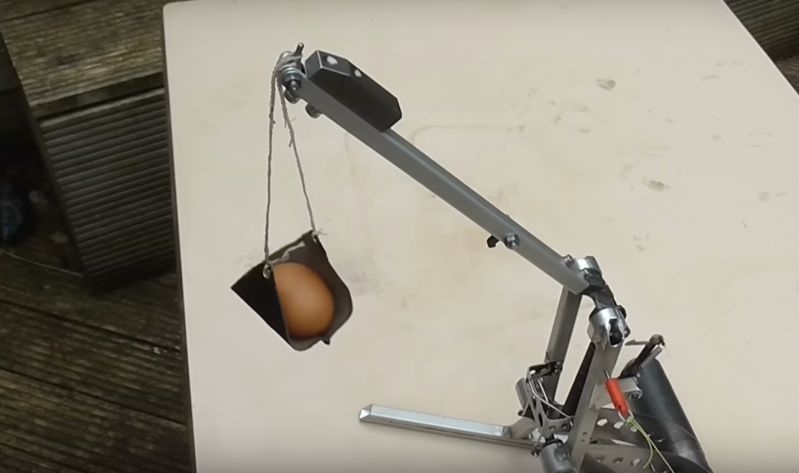Without any sort of restrictions on designs for trebuchets, these medieval siege weapons are known to send 90 kilogram projectiles over 300 meters. The egg-launching trebuchet contest that [AndysMachines] is entering, on the other hand, has a few limitations that dramatically decreased the size of the machines involved. The weight of the entire device is limited to no more than 3 kg, with any physical dimension no more than 300 mm, but that’s more than enough to send an egg flying across a yard with the proper design and tuning for maximum distance.
Trebuchets distinguish themselves amongst other siege weapons by using a falling weight to launch the projectile. The rules of this contest allow for the use of springs, so [AndysMachines] is adding a spring in between the trebuchet arm and the weight in order to more efficiently deliver the energy from the falling weight. More fine tuning of the trebuchet was needed before the competition, though, specifically regarding the stall point for the trebuchet. This is the point where the forces acting on the arm from the projectile and the weight are balanced, and moving this point to allow the projectile to release at a 45-degree angle was needed for maximum distance.
The video goes into a lot of detail about other fine-tuning of a trebuchet like this, aided by some slow-motion video analysis. In the end, [AndysMachines] was able to launch the egg over ten meters with this design. Of course, if you want to throw out the rule book and replace the eggs with ball bearings and the aluminum and steel with titanium, it’s possible to build a trebuchet that breaks the sound barrier.
















Trebuchegg?
Trebuchets are really amazing!
Also have a look at Tom’s creations:
– https://www.youtube.com/watch?v=-gn2RGPqe_A
– https://www.youtube.com/watch?v=RVT5i4nhIGs
He managed 11.8 in the competition, but someone beat him with 17.5 – a balsawood design meaning almost all the weight allowance was weights.
Some very interesting approaches based on a rolling arm, and a few which used the additional 1m height of the launch table as extra potential energy.
Someone with more understanding of it than me could write up a fascinating article comparing the designs.
You really need wheels on a Trebuchet , otherwise it shakes itself to pieces, I think the Romans found this out, and so did my tame mathematician.
Myth busters did a thing about wheels vs no wheels. I think intuition is that if there aren’t any wheels all
The energy goes to flinging the object. But if I remember they shoes that white wheels the weight itself goes more or less straight down as the cart rolls back and forth. Is more efficient or something instead of weight going on an arc. I think.
The winning design in their competition dropped the weight straight, but I still don’t fully understand _that_ mechanism. I’d love to see it written up somewhere.
But this is a small welded metal trebuchet as opposed to large, wooden trebuchets so this one can probably handle the stresses on it more than well enough so he can afford to loose the wheels to loose weight.